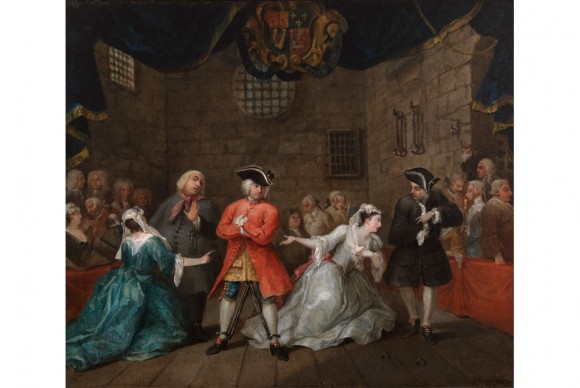The Fine Art Society to offer three standout works by William Hogarth, Eric Gill and William Burges
March 4, 2014 by All Art News
Filed under Art Events & Exhibitions
LONDON.- The Fine Art Society will present The Beggar’s Opera II by William Hogarth (1697-1764), one of the artist’s first works in oil, and one of the earliest paintings ever to depict an English stage performance. Hogarth paintings are very rare and no work of this importance has appeared on the market for many years.
Created during the important transition in Hogarth’s career as he progressed from graphic artist to painter, the work depicts the climactic scene XI in Act III of John Gay’s best known satirical operetta The Beggar’s Opera. In chains, highwayman Macheath stands awaiting execution, flanked by two women who both believe they are his wife. At once comic and dramatic, they plead to their fathers for his release, observed by an audience of aristocratic patrons.

William Hogarth, The Beggar’s Opera II, 1728. Oil on canvas, signed, 47 x 54.6 cm, courtesy of The Fine Art Society
There is a preparatory sketch of the subject in the Royal Library at Windsor Castle. It is the second of five versions painted in oils: the others are in Tate Britain, Yale University, The Yale Center for British Art and Birmingham City Art Gallery.
A lifelong theatre enthusiast, fascinated by the comparison between paintings and stage compositions, Hogarth is once quoted as saying: ‘My picture is my stage, and men and women my players’. 2014 marks the 250th anniversary of Hogarth’s death.
Heralding a move away from his more overtly religious subjects, Eric Gill’s (1882-1940) sensuous nude Headdress celebrates a pure form of female sexuality.
Carved between 20th – 26th February 1928 for an exhibition at the Goupil Gallery, the work was purchased by Sir Hugh Maufe, who displayed it in his dining room at Shepherd’s Hill, Sussex.
The sculpture’s voluptuous breasts, flowing hair and colouring on the lips and nipples have lead many to conclude that the work is inspired by erotic Indian sculpture. Gill’s interest in Indian carving was largely spurred on by his patron, pioneering philosopher of Indian art Ananda Coomaraswamy and friend, the English painter Sir William Rothenstein.
The celebration of the sexualised female figure is a theme Gill would continue to investigate throughout his career.
Rarely on the market, work by William Burges (1827-1881) is characterised by its flamboyance and extravagance, and was celebrated by peers as some of the most brilliant designs and architecture of the day. The Wheel of Fortune, an inlaid octagonal table, is one of Burges’ earliest designs for furniture.
Created for Lieutenant Colonel Somers Cocks as part of an interior scheme for his new house, ‘Treverbyn Vean’ in Cornwall, the table was made by J.G. Crace, inlaid with various woods on an oak base of A.W.N. Pugin’s design.
Amongst the greatest of the Victorian architects, Burges also designed Castell Coch and rebuilt Cardiff Castle under the patronage of the Marquis of Bute from 1869. Jimmy Page, former lead guitarist of Led Zeppelin, now owns Burges’ exquisite self-built and furnished home in Tower House, Kensington.
The Wheel of Fortune is a highlight from the collection of John Scott, which features almost 1,000 pieces of the finest furniture, ceramics, metalwork, glass and sculpture produced in Britain during the 19th century. The collection showcases the genius of progressive British architects, designers, craftsmen and manufacturers working during this period, and illustrates one of the richest and most innovative chapters in the history of design. Over the coming months The Fine Art Society will present a series of spectacular exhibitions featuring works from the John Scott collection, beginning with an exhibition that will be on view at the gallery from 11 June – 4 July 2014.
